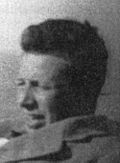Walter Heitler facts for kids
Quick facts for kids
Walter Heitler
|
|
|---|---|

Walter Heinrich Heitler (1904–1981)
|
|
| Born | 2 January 1904 |
| Died | 15 November 1981 (aged 77) |
| Nationality | German |
| Alma mater | Ludwig Maximilian University of Munich |
| Awards | Max Planck Medal (1968) Marcel Benoist Prize (1969) Fellow of the Royal Society |
| Scientific career | |
| Fields | Quantum mechanics |
| Institutions | University of Göttingen University of Bristol Dublin Institute for Advanced Studies University of Zurich |
| Doctoral advisor | Karl Herzfeld |
| Other academic advisors | Arnold Sommerfeld |
| Notable students | Sigurd Zienau |
| Influenced | Linus Pauling |
Walter Heinrich Heitler (born January 2, 1904 – died November 15, 1981) was a German physicist. He made very important discoveries about how tiny particles work, like electrons and light. He also helped connect chemistry with quantum mechanics, especially with his ideas on how atoms join together.
Contents
Early Life and Studies
Walter Heitler started studying physics in 1922. He went to different universities in Germany, including Berlin and Munich. He learned from famous scientists like Arnold Sommerfeld and Karl Herzfeld. In 1926, he earned his doctorate degree.
After his studies, Heitler traveled to learn from other top physicists. He worked with Niels Bohr in Denmark and Erwin Schrödinger in Switzerland. Then, he joined Max Born's team in Germany.
Understanding Atoms and Molecules
During this time, scientists were making big breakthroughs in understanding atoms. They were developing new ways to describe how tiny particles behave. Heitler joined these efforts, applying new ideas to study how atoms and molecules are built.
In Switzerland, Heitler worked with Fritz London. They used new physics ideas to explain how hydrogen atoms stick together to form a molecule. Their work was a huge step because it showed how quantum mechanics could explain chemical bonds. This idea greatly influenced other chemists, like Linus Pauling.
Moving to England
In 1933, Walter Heitler had to leave his job at the university in Germany. This was because of the difficult political situation in the country at the time. Max Born helped him find a new research job in England. Heitler became a research fellow at the University of Bristol.
Career and Discoveries
At Bristol, Heitler continued his important research. He studied how light and matter interact at a very tiny level, a field called quantum electrodynamics. He also worked on quantum field theory, which describes how forces work between particles.
Working with Other Scientists
Heitler often worked with other scientists who had also left Germany. One of his important collaborations was with Hans Bethe. Together, they developed a formula to explain how gamma rays create new particles. This formula is still used today.
In 1936, Heitler published a major book called The Quantum Theory of Radiation. This book became very important for future studies in quantum physics. It was printed many times and translated into other languages.
Cosmic Rays and New Particles
Heitler also helped us understand cosmic rays, which are high-energy particles from space. He predicted the existence of a new particle called the pi meson, which has no electric charge.
In 1937, Heitler learned about new experiments with cosmic rays. He suggested to his colleague, Cecil Powell, that they try a new method using special photographic plates. Heitler and Powell confirmed these observations in 1939. This work helped set Powell on the path to winning the Nobel Prize in Physics in 1950.
Moving to Dublin
In 1941, Heitler moved to Dublin, Ireland. He became a professor at the Dublin Institute for Advanced Studies. Here, he worked with Peng Huanwu on a theory about how particles scatter.
While in Dublin, Heitler also wrote a book called Elementary Wave Mechanics. This book helped many students learn about quantum physics. It was revised and translated many times.
Return to Zurich
Heitler stayed in Dublin until 1949. Then, he became a professor at the University of Zurich in Switzerland. He worked there until he retired in 1974.
Later in his career, Heitler started writing about the connection between science and religion. He wrote several books on this topic in different languages.
Quote
- Physics eats chemistry with a spoon. (This means that physics provides the basic rules and understanding for chemistry.)
Honours and Awards
Walter Heitler received many awards for his important scientific work:
- 1943 – Became a member of the Royal Irish Academy
- 1948 – Became a member of the Royal Society of London
- 1954 – Received an honorary Doctor of Science degree
- 1968 – Awarded the Max Planck Medal
- 1969 – Won the Marcel Benoist Prize
- 1979 – Received the Gold Medal of the Humboldt Gesellschaft
Books
Physics Books
- Walter Heitler Elementary Wave Mechanics: Introductory Course of Lectures (1943)
- Walter Heitler Elementary Wave Mechanics (1945)
- Walter Heitler The Quantum Theory of Radiation (1936)
- Walter Heitler Elementary Wave Mechanics With Applications to Quantum Chemistry (1956)
Science and Religion Books
- Walter Heitler Man and Science (1963)
- Walter Heitler The Nature and the Divine (1974)

